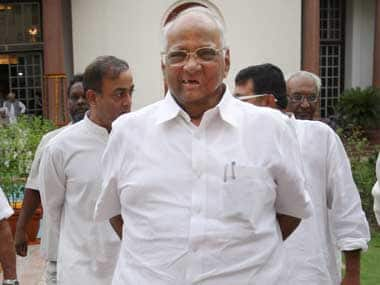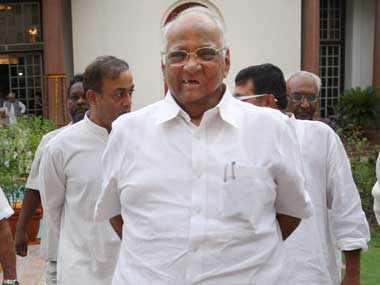Even as the Sharad Pawar-Congress brinkmanship plays itself out over the next few days, the amusing bit is that everyone has discussed the red herrings instead of the real issue. We have been told that Pawar was miffed about being denied the No 2 position in cabinet (unlikely), that the Congress treats the NCP as a mere appendage (true, but what can you do if you have very few MPs?), that Pawar’s real target is Maharashtra CM Prithviraj Chavan (possible), and that he wants to install nephew Ajit Pawar as CM of Maharashtra and daughter Supriya Sule as a central minister (sure, no harm in dreaming). However, the reality is that the Congress can easily meet him half-way on at least some of these issues — and Pawar could have ensured some gains for himself and the party without all this public posturing. As for targeting Prithviraj Chavan, there is
enough opposition to him
within the Congress itself. Pawar need not have put himself out on a limb for this. In fact, Pawar has
now held back on his threat
to opt out of the UPA altogether — and will probably allow himself to be mollified with soft words from Manmohan Singh and some minor concessions. Clearly, Pawar knows his gun isn’t loaded. Why, then, did he make a public spectacle of it? The answer could be that Pawar is aware of his own powerlessness in the UPA — and the public airing of grievances was merely intended to
assure himself that he was still relevant.
[caption id=“attachment_388660” align=“alignleft” width=“380”]
 Pawar’s eye on Delhi actually worked against him. PTI[/caption] Pawar’s frustration stems from the same reason that prompted Pranab Mukherjee to ultimately opt for the presidency: a realisation that he would always be denied the top job — or even real power at the centre — for reasons other than capability. In Pawar’s case, the sense of impotence is further compounded by the fact that he is not merely a capable politician, but someone with a power base in Maharashtra. His image may not be squeaky clean, but his power is real, unlike Pranab-da’s. However, this power is about to diminish, both because of Pawar’s
medical problems
and age (72). His best days are over, and he has already announced that he will not contest the 2014 elections. Pawar’s current powerlessness at the centre is the result of a political miscalculation: even though he has a political base around Pune and the Maratha heartland surrounding it, he has always positioned himself for a larger role at the centre. He did not realise early enough that political power at the centre comes from being a very strong regional power — like Mulayam Singh or Mamata Banerjee or M Karunanidhi. He thus failed to make himself the indispensable power in Maharashtra, preferring to focus on cultivating allies in other national parties in the hope that a fractured mandate at the centre will allow him to become PM with help from his old relationships. His best chance was in the early 1990s, when Narasimha Rao was PM and he was in the central cabinet as defence minister. There was talk at the time that if anyone could topple Rao, it would be Pawar, given his wide contracts in other parties. But in 1993, after the first Mumbai blasts, Rao got the upper hand and sent Pawar back as CM to Maharashtra. Pawar did a commendable job of restoring sanity in Maharashtra, but in doing this he got reduced to a regional politician — which he did not want to be. In 1999, in order to make another pitch for the prime ministership, he made Sonia Gandhi’s foreign origins an issue and formed his own Nationalist Congress Party in the hope that the next hung Parliament will give him an even chance to take a shot at PM. But 2004 brought the Congress as the largest party in Parliament, and Pawar could play only a minor role. The short point is this: Pawar’s eye on Delhi actually worked against him. Instead of making NCP a strong regional force, which would have given him bargaining clout in Delhi, he ended up making NCP a weak copy of the Congress in Maharashtra. This is why, despite his seniority, he could never wield the political clout of other regional powerhouses in Delhi. In 2009, with more hope than realism, Pawar again
set off rumours
that he could be a candidate for PM in case the Congress failed to do better than before — and parties like the
Left
and Samajwadi Party
fanned these hopes.
But the 2009 elections turned out to be one big celebration for Congress. Pawar’s hopes ended after that. Pawar’s objective of handing over power to family is still an unfinished business. His NCP has held its own primarily because Raj Thackeray’s MNS has managed to damage the Sena-BJP alliance by undercutting their votes. Pawar would be completely sidelined if, in the next elections, the Shiv Sena, MNS and BJP get their act together. The current fuss in Delhi is the Maratha strongman’s last hurrah before he is permanently diminished. This is what would have happened to Pranab Mukherjee in 2014 after Rahul’s entry. He saw the writing on the wall and headed off to Rashtrapati Bhavan. Pawar is trying to salvage what is possible well before 2014. After that, even if Ajit Pawar and Supriya Sule manage to hold their own in politics, Pawar himself will be history.
Pawar’s eye on Delhi actually worked against him. PTI[/caption] Pawar’s frustration stems from the same reason that prompted Pranab Mukherjee to ultimately opt for the presidency: a realisation that he would always be denied the top job — or even real power at the centre — for reasons other than capability. In Pawar’s case, the sense of impotence is further compounded by the fact that he is not merely a capable politician, but someone with a power base in Maharashtra. His image may not be squeaky clean, but his power is real, unlike Pranab-da’s. However, this power is about to diminish, both because of Pawar’s
medical problems
and age (72). His best days are over, and he has already announced that he will not contest the 2014 elections. Pawar’s current powerlessness at the centre is the result of a political miscalculation: even though he has a political base around Pune and the Maratha heartland surrounding it, he has always positioned himself for a larger role at the centre. He did not realise early enough that political power at the centre comes from being a very strong regional power — like Mulayam Singh or Mamata Banerjee or M Karunanidhi. He thus failed to make himself the indispensable power in Maharashtra, preferring to focus on cultivating allies in other national parties in the hope that a fractured mandate at the centre will allow him to become PM with help from his old relationships. His best chance was in the early 1990s, when Narasimha Rao was PM and he was in the central cabinet as defence minister. There was talk at the time that if anyone could topple Rao, it would be Pawar, given his wide contracts in other parties. But in 1993, after the first Mumbai blasts, Rao got the upper hand and sent Pawar back as CM to Maharashtra. Pawar did a commendable job of restoring sanity in Maharashtra, but in doing this he got reduced to a regional politician — which he did not want to be. In 1999, in order to make another pitch for the prime ministership, he made Sonia Gandhi’s foreign origins an issue and formed his own Nationalist Congress Party in the hope that the next hung Parliament will give him an even chance to take a shot at PM. But 2004 brought the Congress as the largest party in Parliament, and Pawar could play only a minor role. The short point is this: Pawar’s eye on Delhi actually worked against him. Instead of making NCP a strong regional force, which would have given him bargaining clout in Delhi, he ended up making NCP a weak copy of the Congress in Maharashtra. This is why, despite his seniority, he could never wield the political clout of other regional powerhouses in Delhi. In 2009, with more hope than realism, Pawar again
set off rumours
that he could be a candidate for PM in case the Congress failed to do better than before — and parties like the
Left
and Samajwadi Party
fanned these hopes.
But the 2009 elections turned out to be one big celebration for Congress. Pawar’s hopes ended after that. Pawar’s objective of handing over power to family is still an unfinished business. His NCP has held its own primarily because Raj Thackeray’s MNS has managed to damage the Sena-BJP alliance by undercutting their votes. Pawar would be completely sidelined if, in the next elections, the Shiv Sena, MNS and BJP get their act together. The current fuss in Delhi is the Maratha strongman’s last hurrah before he is permanently diminished. This is what would have happened to Pranab Mukherjee in 2014 after Rahul’s entry. He saw the writing on the wall and headed off to Rashtrapati Bhavan. Pawar is trying to salvage what is possible well before 2014. After that, even if Ajit Pawar and Supriya Sule manage to hold their own in politics, Pawar himself will be history.
The last hurrah: The impotence of being Sharad Pawar
R Jagannathan
• July 24, 2012, 12:32:51 IST
The political crisis induced by Sharad Pawar’s new posturing is just that: posturing. It is evidence of his growing irrelevance.
Advertisement
)